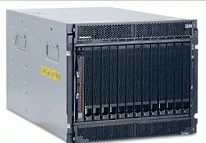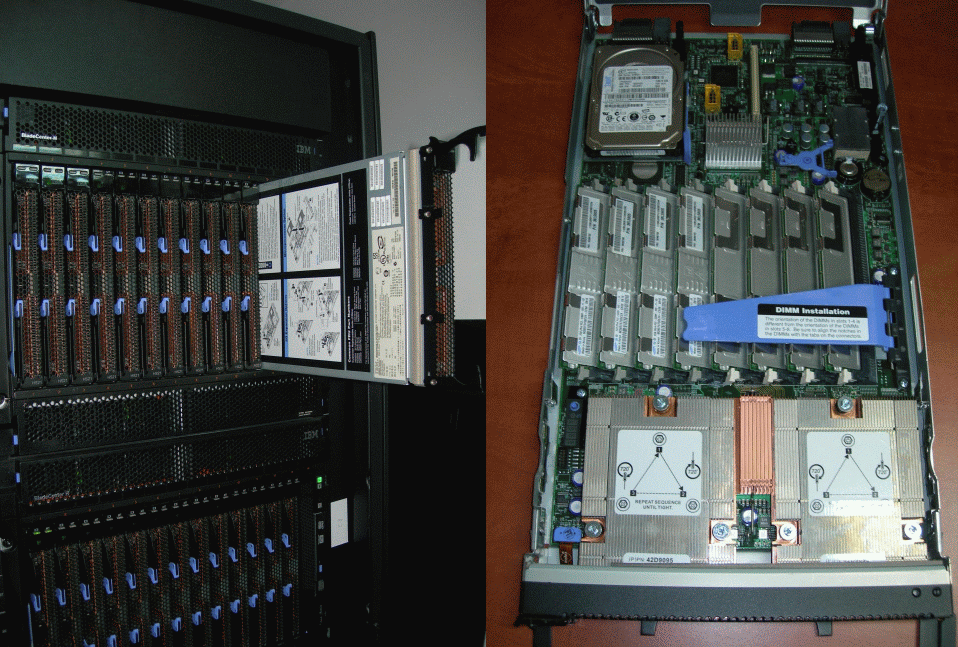|
|
||||||||||||||
Modeling and Simulation Group in Materials Science: www.hpc-icf.ro |
||||||||||||||
|
|
|||||||||||||
| Last modified: September 12 2009 12:14:48. | ||||||||||||||
|
| ||||||||||||||
Institute
of Physical Chemistry "Ilie Murgulescu", Romanian Academy Modeling and Simulation Group in Materials
Science:
www.hpc-icf.ro ASSG
Project
Hardware
Tutorials
Hardware
The hpc-icf cluster is an IBM based Blade Cluster
Racks
(2 pieces): Frames IBM NetBay de 42U
(1U = 1.75"). They are the physical
"boxes" that hold most of a cluster's other components: Nodes of various types Switch components Other network
components Parallel file system disk resources (usually in
separate racks) Vary in size/appearance between the different Linux
clusters at ASSG. Power and console management - Racks include hardware
and software that allow system administrators to perform most tasks
remotely. IBM
BladeCenter H Chassis (5 pieces): IBM BladeCenter H is a powerful platform
built with the enterprise customer in mind, providing industry-leading
performance, innovative architecture and a solid foundation for
virtualization: Delivers high performance to run the
most demanding applications and simulations at blazing-fast speeds Provides easy integration to promote
innovation and help manage growth, complexity and risk Protects your investment by being
compatible with the entire IBM BladeCenter® family Height: 9U Bays: 14 bays Power modules: 2900W AC I/O modules: 4 high-sped, 4 bridge, 10 GIGABIT ETHERNET,
INFINIBAND Nodes
(64+2
pieces): The basic building block of a Linux cluster is the
node. A node is essentially an independent PC. However, some important
features of cluster nodes distinguish them from typical desktop
machines: Low form-factor - Clusters nodes are very thin in
order to save space. For example, the Opteron cluster nodes have a
form factor of approximately 1U (U = 1.75"). Rack Mounted - Nodes are mounted compactly in a
drawer fashion to facilitate maintenance, reduced footprint, etc. Remote Management - There is no keyboard, mouse,
monitor or other device typically used to interact with a desktop
machine. All interaction with a cluster node takes place remotely
over a network. Nodes are typically configured into three types,
according to their function: Compute nodes - 64 nodes (blades) that run
user jobs: IBM HS21 XM - The IBM BladeCenter® HS21 XM delivers optimal performance for
enterprise environments with expanded memory and processor
performance. This high-density blade server is supported in all IBM
BladeCenter chassis and features low-voltage processors for better
energy management. - Characteristics: 16 Gb memory per blade, IBM
146GB SAS 10kRPM, two high-performance Dual-Core or Quad-Core
Intel® Xeon® Processors, 4 Integrated Dual Gigabit Ethernet
controllers Login node - The name of the frontend
server is fep.hpc-icf.ro (IP:193.231.132.66). This is where you
login for access to the compute nodes. Storage node - The server fep.hpc-icf.ro
(IP:193.231.132.65) is dedicated for fileservers. It connects the
compute nodes to essential file systems which are mounted on disk
storage devices. It is used by system administrator to manage the
entire cluster. It is not accessible to users. on each node there are two processors
quad-core Intel Xeon with the characheristics: frequency
2.0/2.5 GHz, cache L2 de 12MB, FSB 1333MHz Low form-factor - Clusters nodes are very thin in
order to save space. For example, the Opteron cluster nodes have a
form factor of approximately 1U. It provides binary
compatibility with applications running on previous members of Intel’s
IA-32 architecture, hyper-threading technology, enhanced branch prediction
and enables system support for up to 64 GB pf physical memory. Memory:
16GB RAM DDR FBDimm C667MHz ECC CL5 Hard
Disk: IBM 146GB SAS 10000rpm Storage
equipments: 12
hard-disks of 300GB SAS, 15000rpm, hot-swap, Support for RAID 0/1/
5/0, Dynamic Volume Expansion, Dynamic Raid Level Migration, Dynamic
Segment Size Migration UPS
(4 pieces): 6U, rackmountable, with support for 4
batteries rackmountable, 10000 VA (8000 W), 10 minutes back-up for 5000
W load, Switch
(2 pieces):
Linksys Gigabit Smart Switch 48 ports 10/100/1000 Mbps , 2
combo SFPs, Console
(1 piece):
monitor 17” TFT, keyboard, mouse Liebert
type Hiross HPM M66OA / 2xHCE 49:
total cooling 70.5 kW, cooling efficiency 0,93
(65,7/70.5), performance coefficient 3,35, air debit 13470 m3/h, electric power 400 V (± 10
%)/3Ph/50Hz ventilator 2 pieces working temperatures
-20oC : 40oC HPC Main Partners National Institute of
Materials Physics Magurele, Romania
Sofia, Bulgaria News
Investigated
Systems
Atomic Scale
Nanoscale
Mesoscale
Macroscale
MultiScale
Some HPC
Centers
HPC
Projects, EU EGEE2,
EU NCIT
Cluster, RO HPCx
Consortium, UK SciTech,
UK JSC
Jülich, DE Barcelona SC,
ES HPCVL,
CA HPC-Europa2,
FR PNL, US ASC
Livermore, US ASC
- NNSA, US CMCS
Belgrade, YU ICM
Warshaw, PL CSC-KIST,
KO

Research
Members
User Projects
Software
Accounts
Administration
Publications
Conferences
Links



Cooling System:
Last modified: September 12 2009 12:14:48.